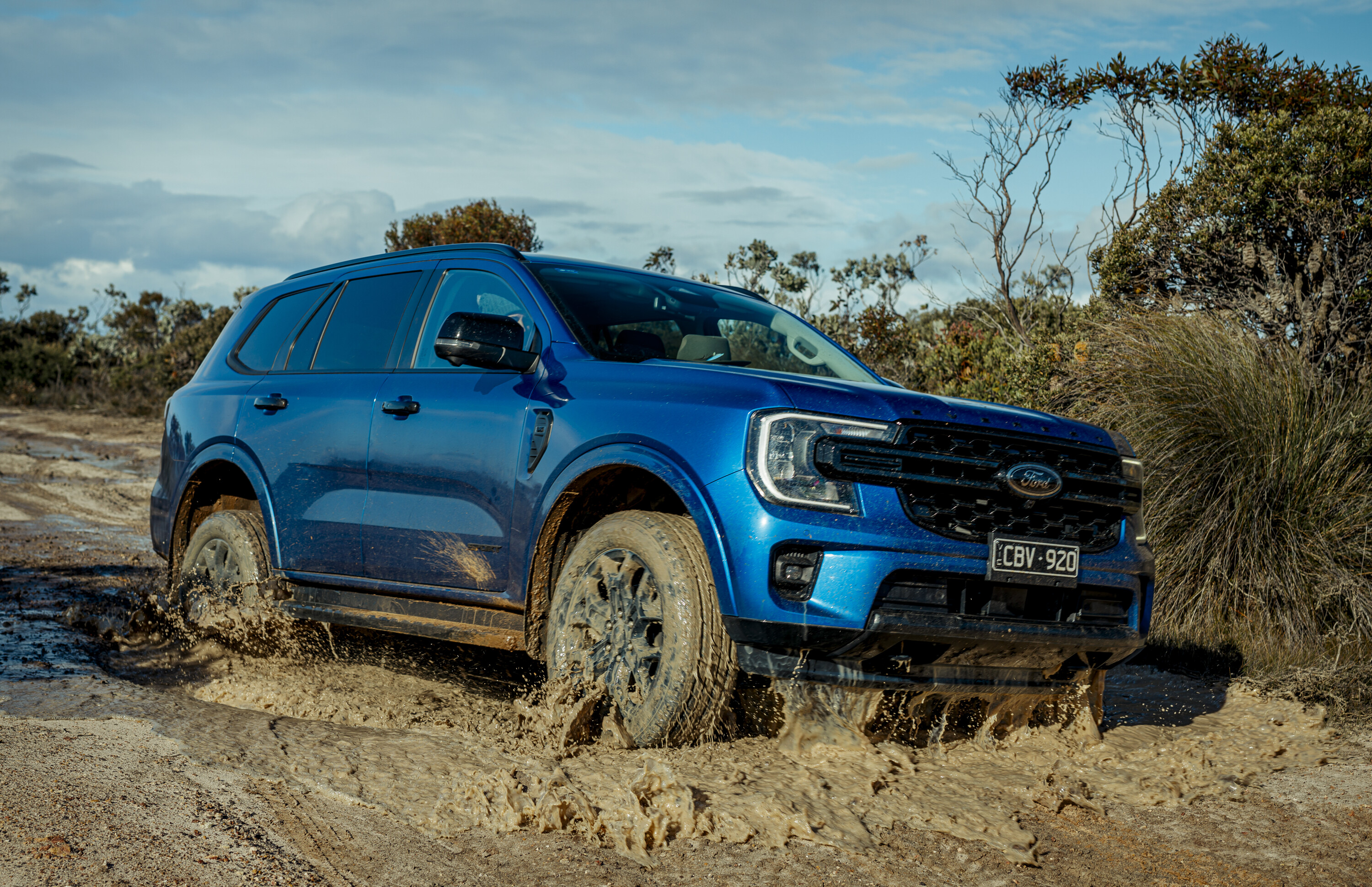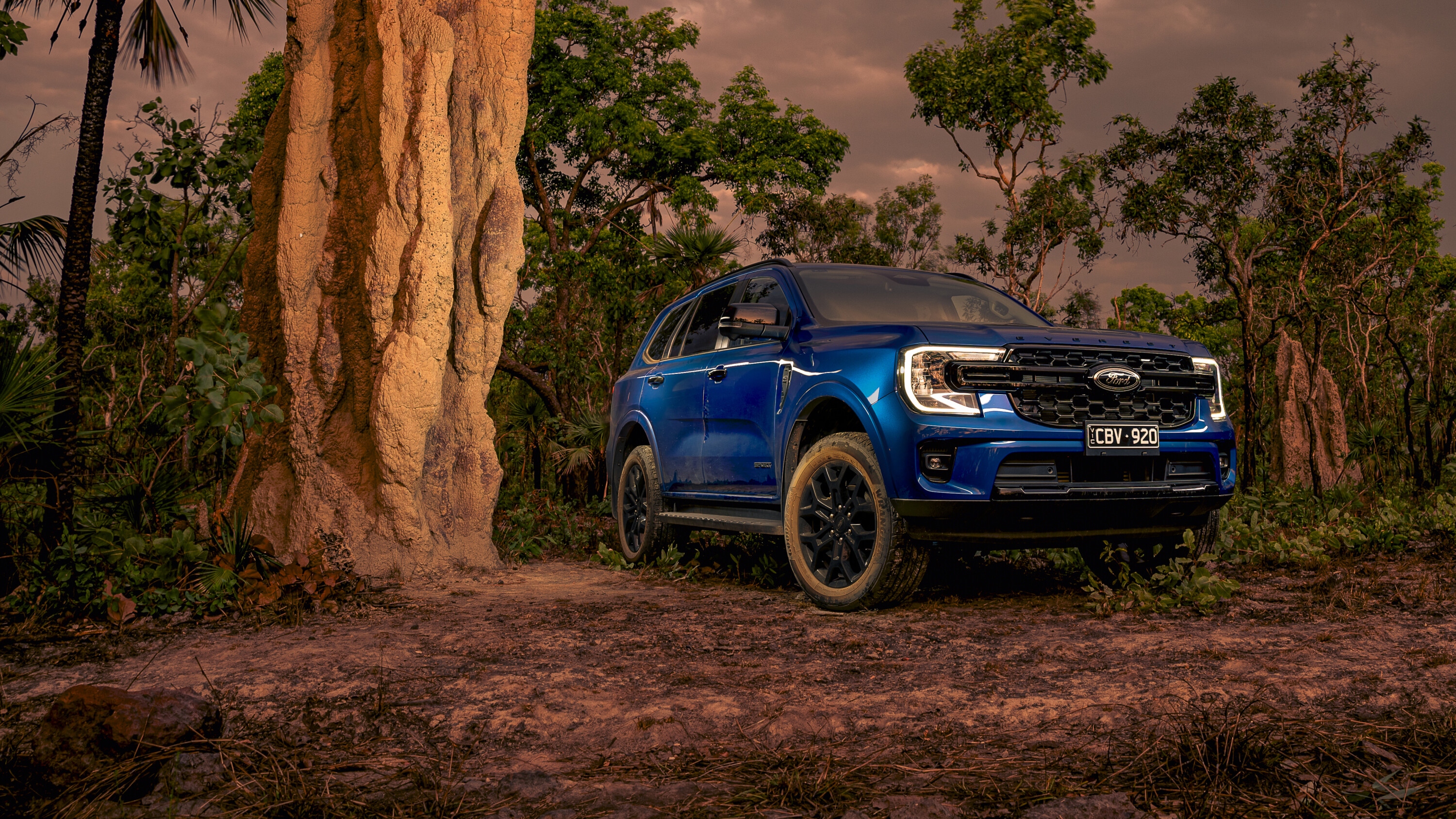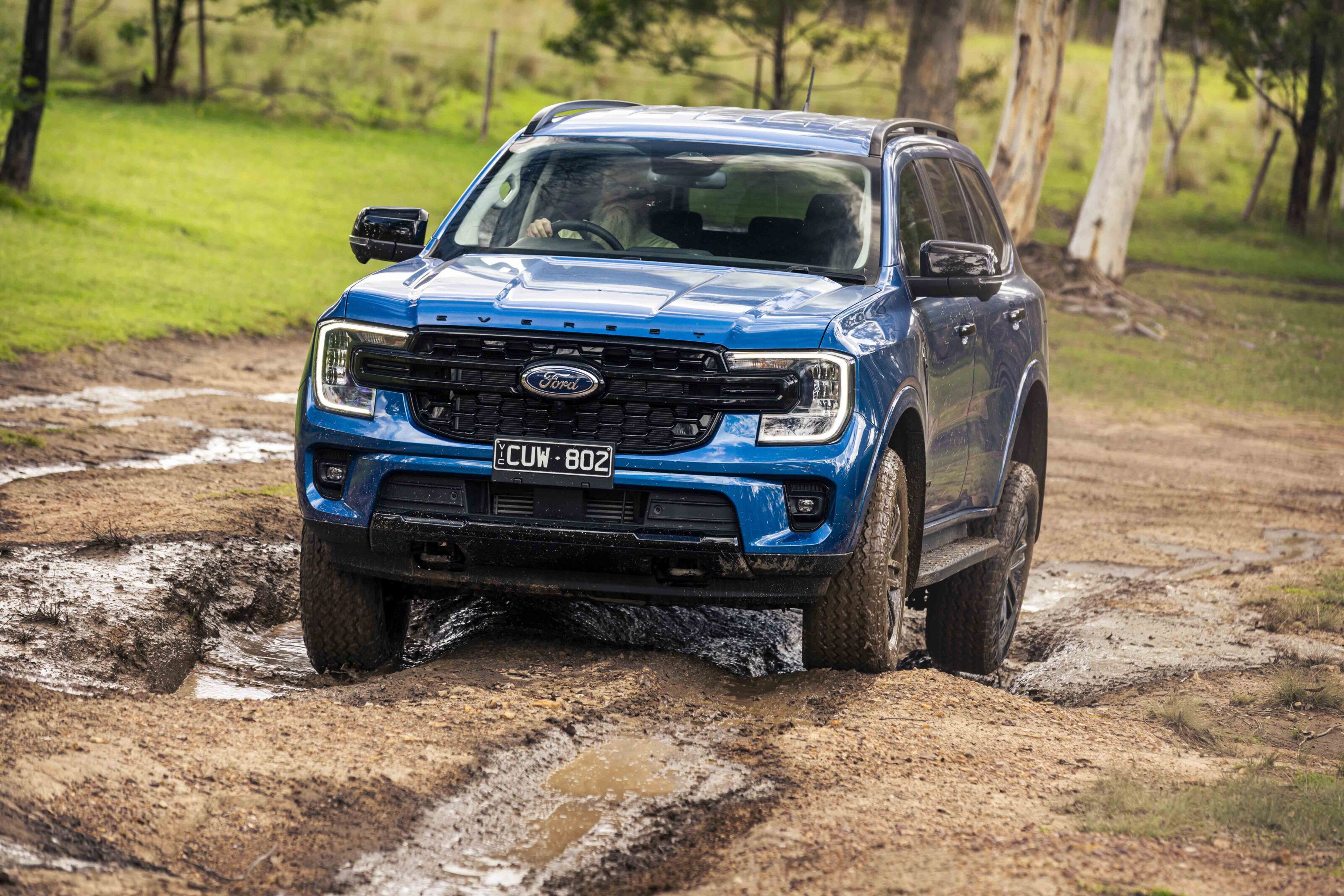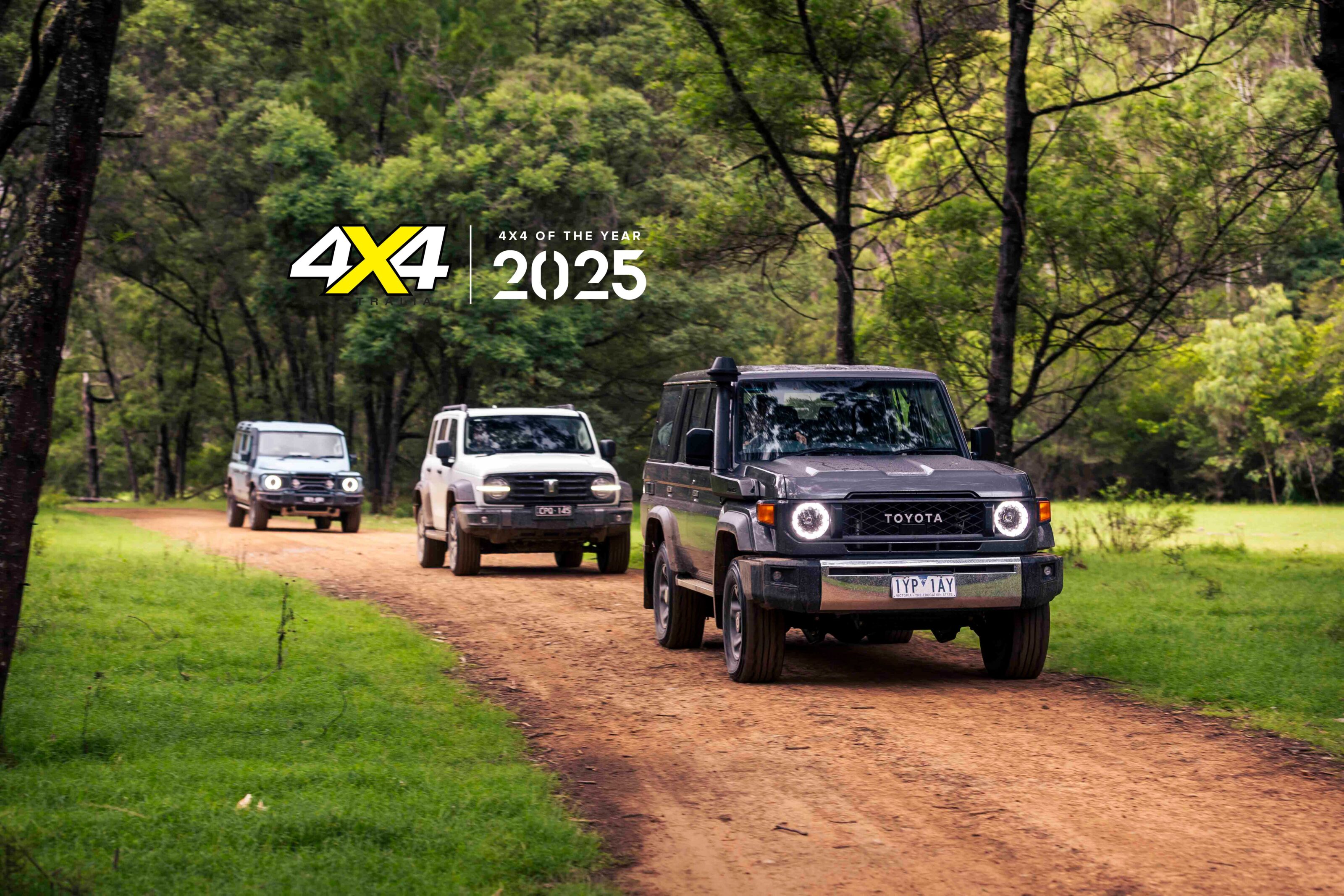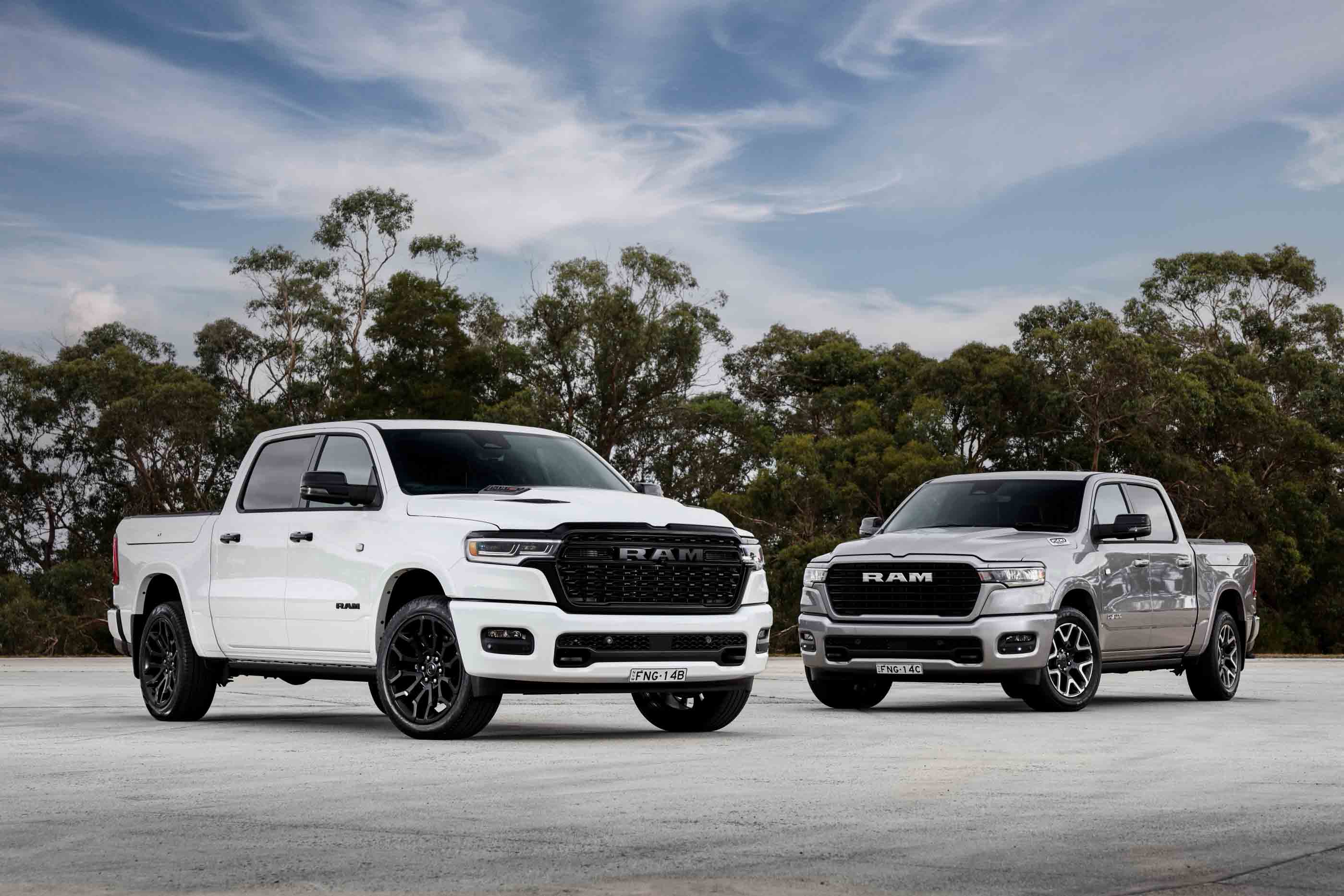Score breakdown
Things we like
- Great powertrain combinations
- Benchmark ride and handling for a ute-based SUV
- Extensive tech features
- Spacious and practical cabin
Not so much
- Ride not perfect when roads get rough
- Manual mode not ergonomic
- Occasional transmission shunt
The Ford Everest is a large five-door, three-row SUV that is spacious and comfortable for up to seven occupants, and is one of the smoothest and most refined SUVs of its type.
Based on the Ford Ranger ute platform, this is one of the better ute-based SUVs for driver engagement and up-to-the-minute standard safety equipment, as well as being a strong heavy towing candidate, with its 3500kg (braked) capacity.
Even though it’s not built here, a lot of the Everest’s engineering was done in Australia, so it could lay claim to being built for our conditions more than most. The new Everest is a new benchmark for large 4WD ute-based wagons.
In addition to the Wheels COTY award, the Everest was also judged Best Off-Road Large SUV Under $70K and Best Overall Large SUV in our Wheels Best Large SUVs series.
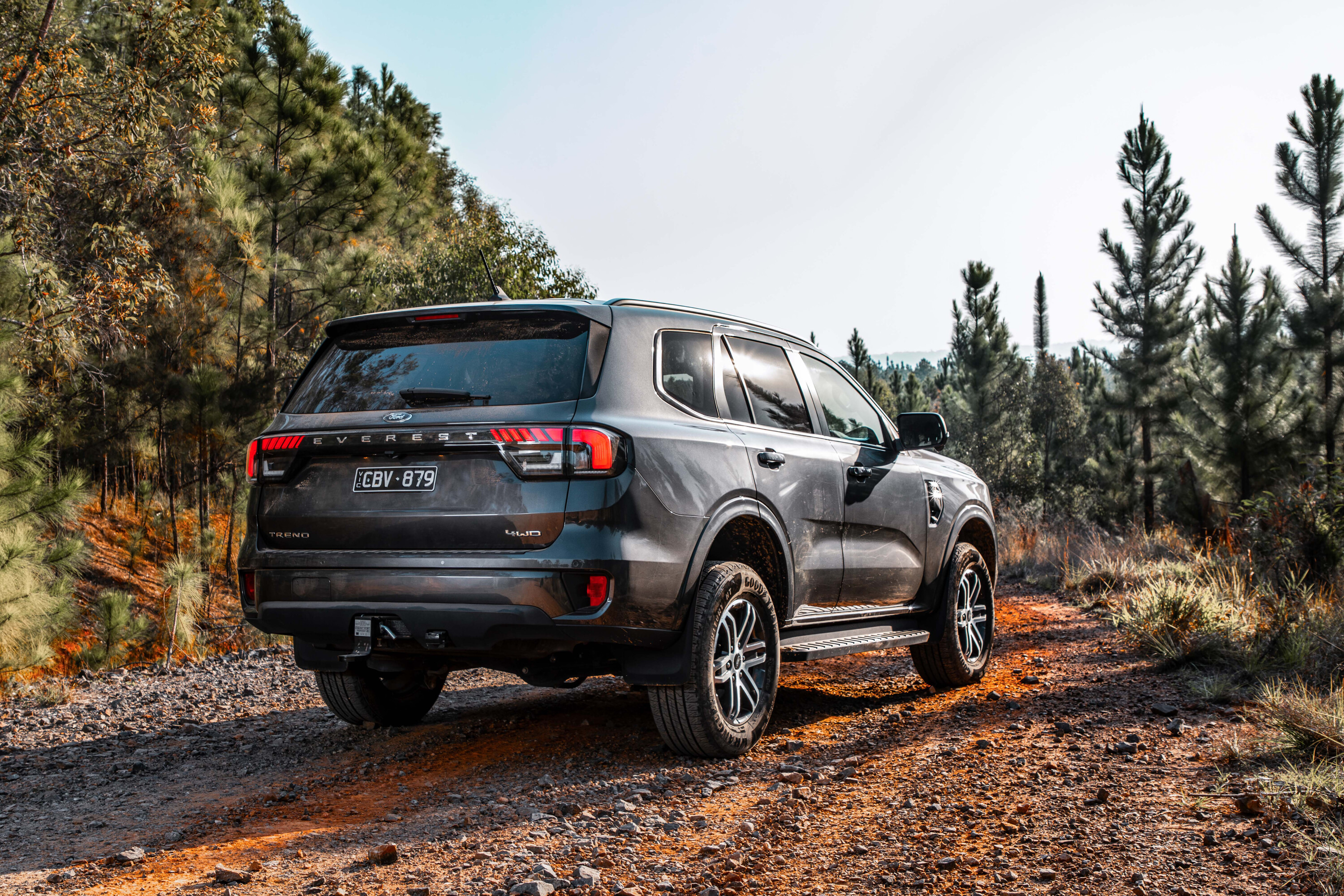
JUMP AHEAD
- Pricing
- What body styles are available for the Ford Everest?
- What features are standard in every Ford Everest?
- What key features do I get if I spend more?
- How safe is the Ford Everest?
- How comfortable and practical is the Ford Everest?
- How much boot space does Ford Everest have?
- I like driving – will I enjoy this car?
- Which Ford Everest engine uses the least fuel?
- What is the Ford Everest’s towing capacity?
- How long is the warranty and what are the Ford Everest’s servicing costs?
- Which version of the Ford Everest does 4X4 Australia recommend?
Pricing
The Everest has a choice of two diesel engines, either a 4×2 or 4×4 drivetrain and is automatic-only. Both engines provide tractable torque, a good reserve of power and acceptable fuel economy.
The Ford Everest range all comes with the technology we all expect such as Apple CarPlay and Android Auto connectivity, and comprehensive safety resulting in a five-star ANCAP result. The Ford five-year/unlimited km warranty is about average.
| 2024.5 Ford Everest variant | Pricing |
|---|---|
| Ambiente 4×2 bi-turbo diesel | $53,990 |
| Ambiente 4×4 bi-turbo diesel | $58,990 |
| Sport 4×2 bi-turbo diesel | $63,490 |
| Trend 4×4 bi-turbo diesel | $66,790 |
| Sport 4×4 V6 diesel | $72,490 |
| Platinum 4×4 V6 diesel | $79,490 |
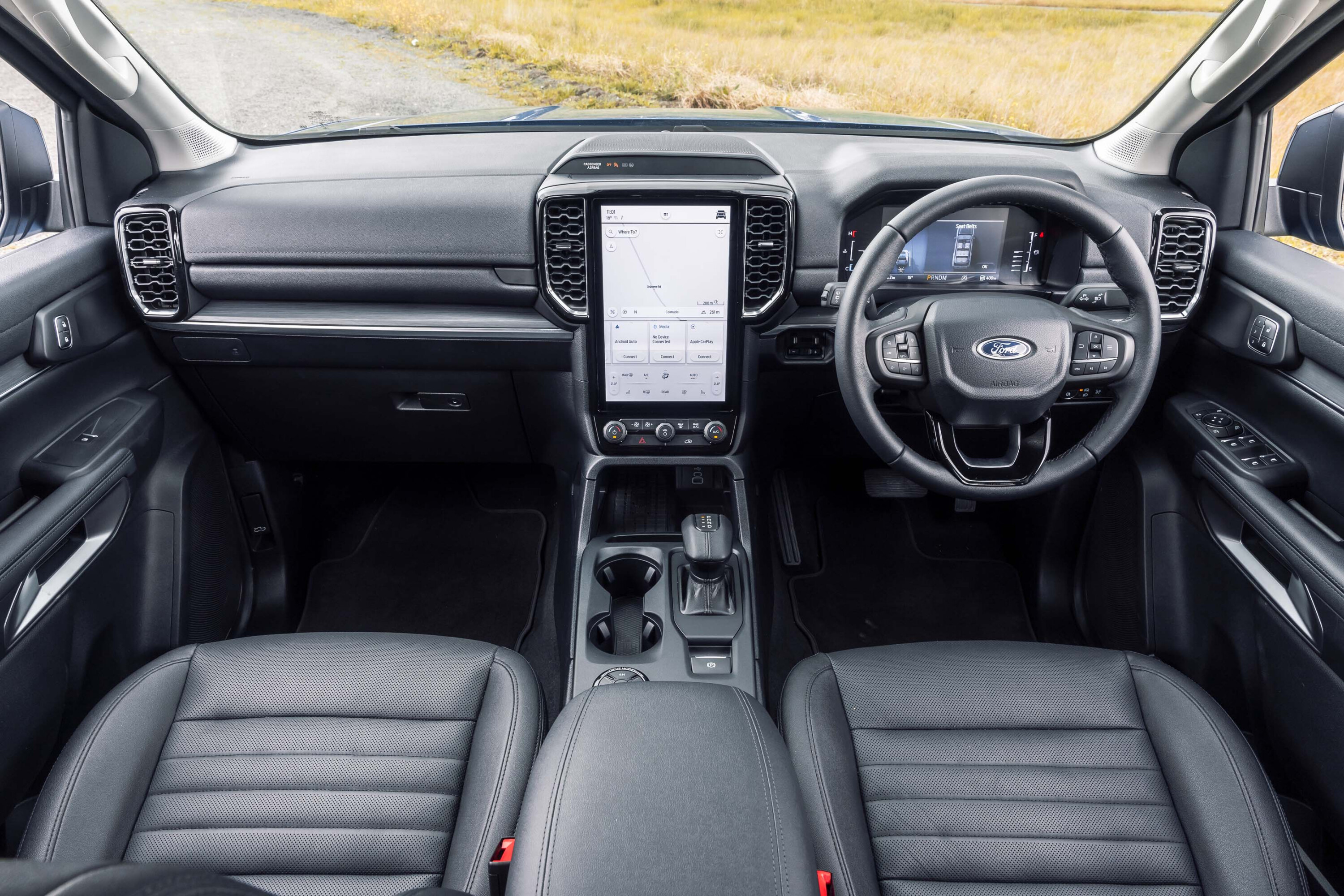
What body styles are available for the Ford Everest?
Five-door SUV only. The Everest drives either its rear wheels or all four wheels, depending on the version.
It is classed as a large SUV, and aside from obvious sheetmetal changes, different trim specs and the use of a coil-spring rear axle instead of leaf-spring, it shares much with its ute sibling the Ford Ranger.
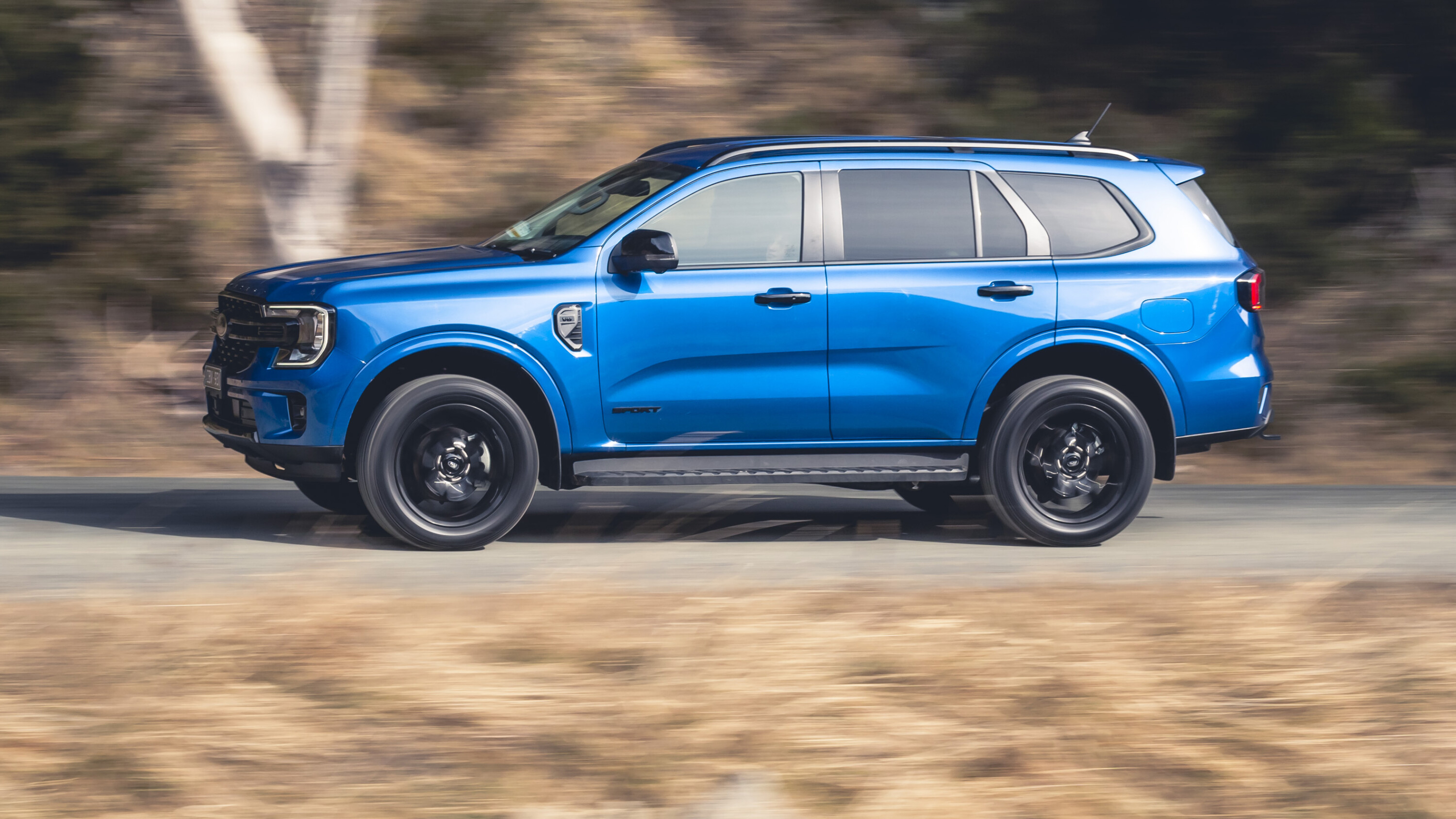
What features are standard in every Ford Everest?
The features listed below are standard in the entry-level Ambiente model and will appear in higher-grade models, unless replaced by more premium equivalent features.
| 2024.5 Ford Everest Ambiente standard features | |
|---|---|
| 17-inch alloy wheels with full-size spare (18-inch alloys with all-terrain tyres optional, $1350, 4×4 only) | LED headlamps and daytime running lights |
| Five seats (seven-seat optional, $1200) | Front fog lamps |
| 10.1-inch Sync 4 infotainment system | LED tail-lamps |
| Wireless Apple CarPlay and Android Auto | Power-folding exterior mirrors |
| Connected satellite navigation | Rain-sensing wipers |
| DAB+ digital radio | Keyless entry and push button start |
| FordPass Connect with embedded modem | Dual-zone climate control |
| Eight-speaker audio system | Black side steps |
| 8-inch digital instrument cluster | Two front tow hooks |
| Wireless phone charger | Driveru2019s floor mat |
| Remote startu00a0 | Electrochromatic rear-view mirror |
| Cloth upholstery | Pull-out cup holders |
| Eight-way manually adjustable driver’s seat | Open storage shelf |
| Four-way manually adjustable passenger seat | Steel underbody protection (4×4 only) |
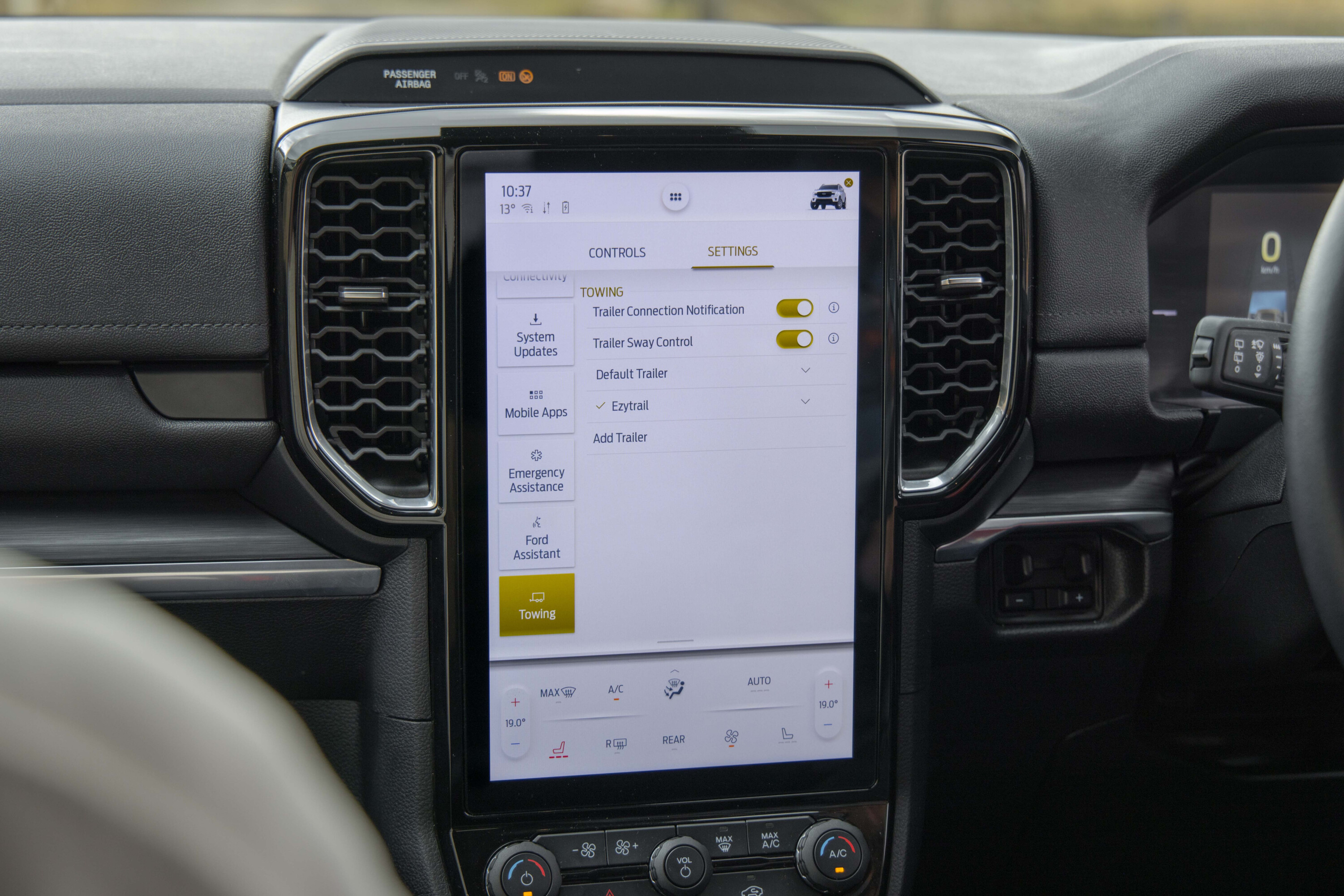
What key features do I get if I spend more?
The entry Everest model, the Ambiente, has cloth seats, 10.1-inch touchscreen, five seats and 17-inch wheels.
All Ford Everests in Ambiente, Trend and Sport trim have a 2.0-litre bi-turbo diesel as standard, with the 3.0 V6 turbo-diesel in Sport 4WD and standard for Platinum. All have a 10-speed automatic and the only major mechanical option for Ambiente and Sport trim levels is to choose either the 4×2 (rear-wheel drive only) drivetrain or full-time, dual-range 4×4, which in Sport and Platinum you must choose the V6 diesel engine.
Aside from the steel underbody protection plates and locking rear diff only available on 4×4 (where is it standard on all spec levels), there is no difference otherwise between 4×2 and 4×4 in trim line features.

For extra equipment over Ambiente, you could spend more for an Everest Trend, where the extra money brings a third row of seats (making it a seven-seater), power tailgate, and rear privacy glass. Zone lighting, black stand-off roof rails and pro-trailer back-up assist (optional) were added early in 2024.
| Everest Trend (in addition to Ambiente) | |
|---|---|
| Zone lighting (new) | Power-folding, heated side mirrors with puddle lamps |
| Black stand-off roof rails (new) | Leather upholstery |
| 18-inch alloy wheels (all-terrain tyres optional, $700) | Eight-way power adjustable driveru2019s seat |
| Seven seatsu00a0 | Leather-wrapped steering wheel |
| 12.0-inch infotainment system | Driver and front passenger floor mats |
| Rear privacy glass | Second upper glove box (no open shelf) |
| Electric tailgate | Off-road screen |
| Selectable drive modes (sand/mud and ruts modes) | |
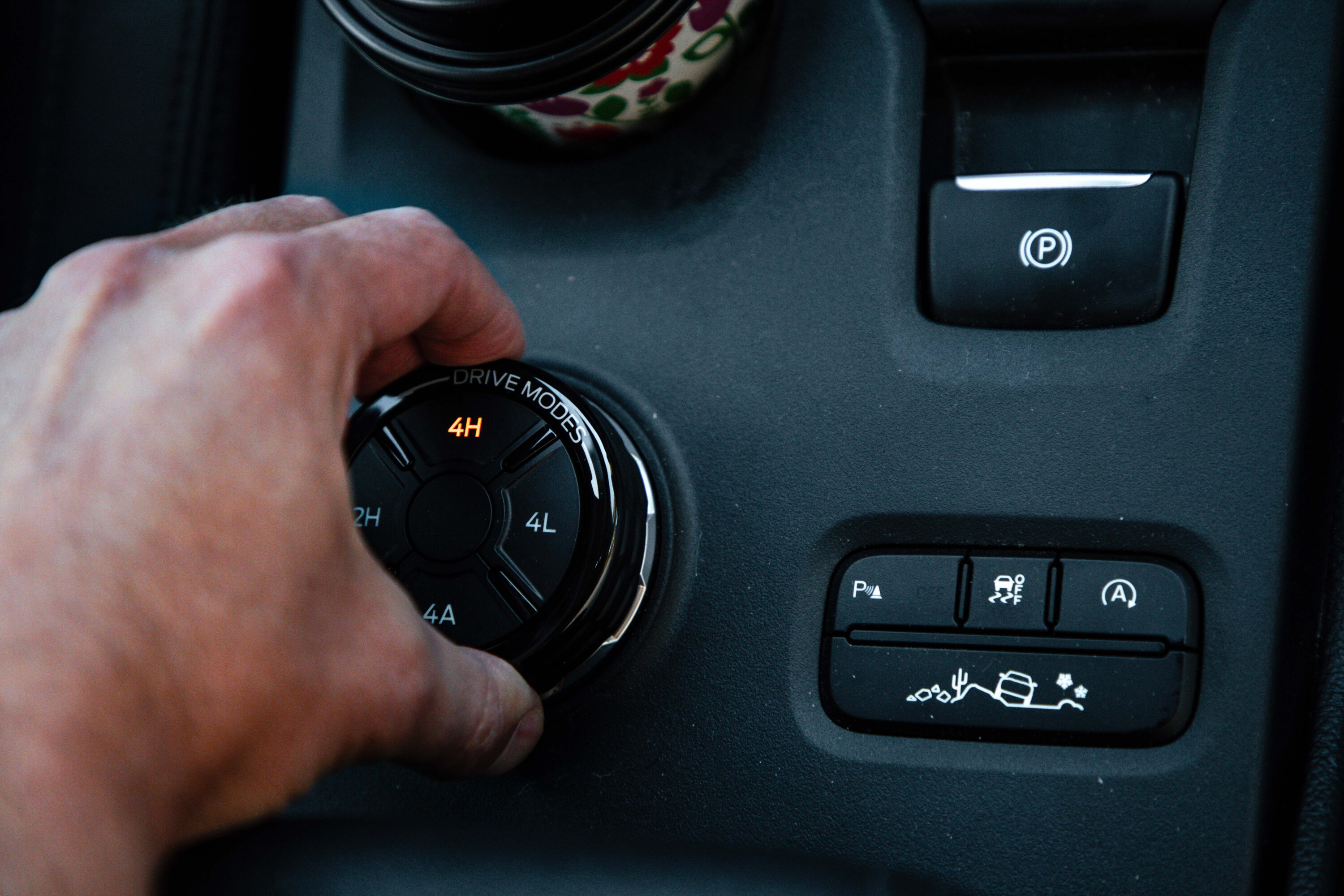
| Everest Sport (in addition to Trend) | |
|---|---|
| 20-inch black alloy wheels (18-inch alloy wheels with all-terrain tyres optional at no cost) | 10-way power-adjustable driveru2019s seat with memory |
| 10-speaker audio system | Eight-way power-adjustable passenger seat |
| Black exterior trim with Sport bonnet lettering | Unique interior colour accents |
| Leather upholstery with Sport embossing | Hands-free electric tailgate |
| Heated and ventilated front seats | |
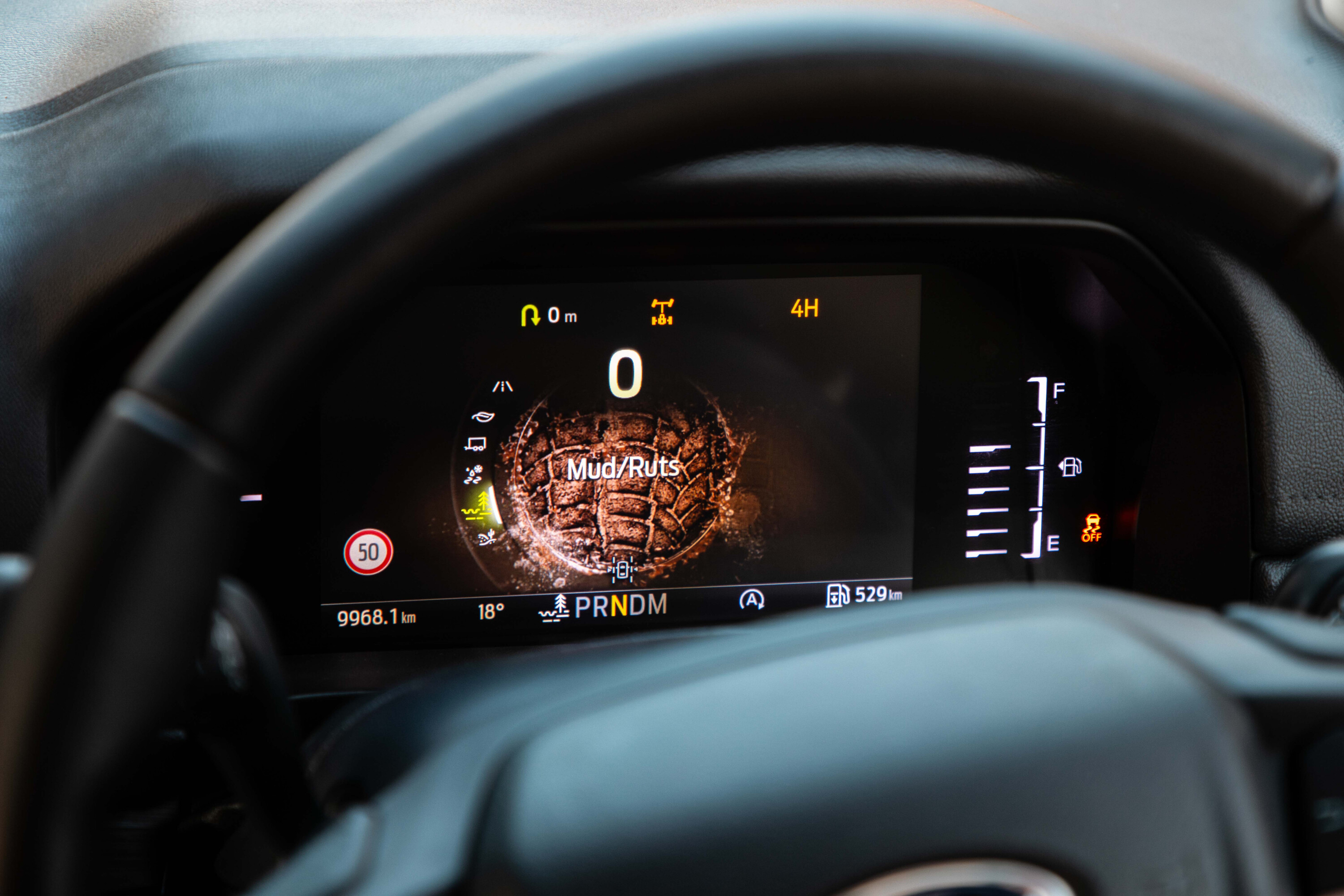
| Everest Platinum (in addition to Sport) | |
|---|---|
| 21-inch alloy wheels (18-inch alloy wheels with all-terrain tyres optional at no cost) | Tyre pressure monitoring system |
| 12.4-inch digital instrument cluster | Plastic underbody protection (steel available as a no-cost option) |
| 12-speaker Bang and Olufsen audio system | Satin chrome accents |
| Matrix LED auto-levelling headlights | Premium leather-accented quilted seats |
| Dual-panel power-sliding panoramic sunroof | Heated steering wheel |
| Silver roof rails | Heated outer second-row seats |
| Power-folding third-rowu00a0 | Premium front and rear floor mats |
| Ambient lighting | 360-degree camera system |
| Automatic park assist | |

How safe is the Ford Everest?
The Ford Everest is laden with safety features with all models fitted with the most comprehensive active and passive safety systems, including autonomous emergency braking (AEB), a lane support system (LSS) with lane keep assist (LKA) and emergency lane keeping (ELK) functionality that helps steer the Everest within the road markings.
The AEB can initiate a full emergency stop automatically from speeds up to 80km/h if the system senses you are in danger of driving into something. First it sounds a warning; if you ignore that, it applies the brakes partially; and if you do not intervene it applies maximum braking.
The AEB is capable of detecting and reacting to vulnerable road users, such as pedestrians and cyclists, in daylight. There’s also rear AEB, which fwill warn of an obstacle and stop when vehile when travelling in reverese at speeds between 2-12km/h.
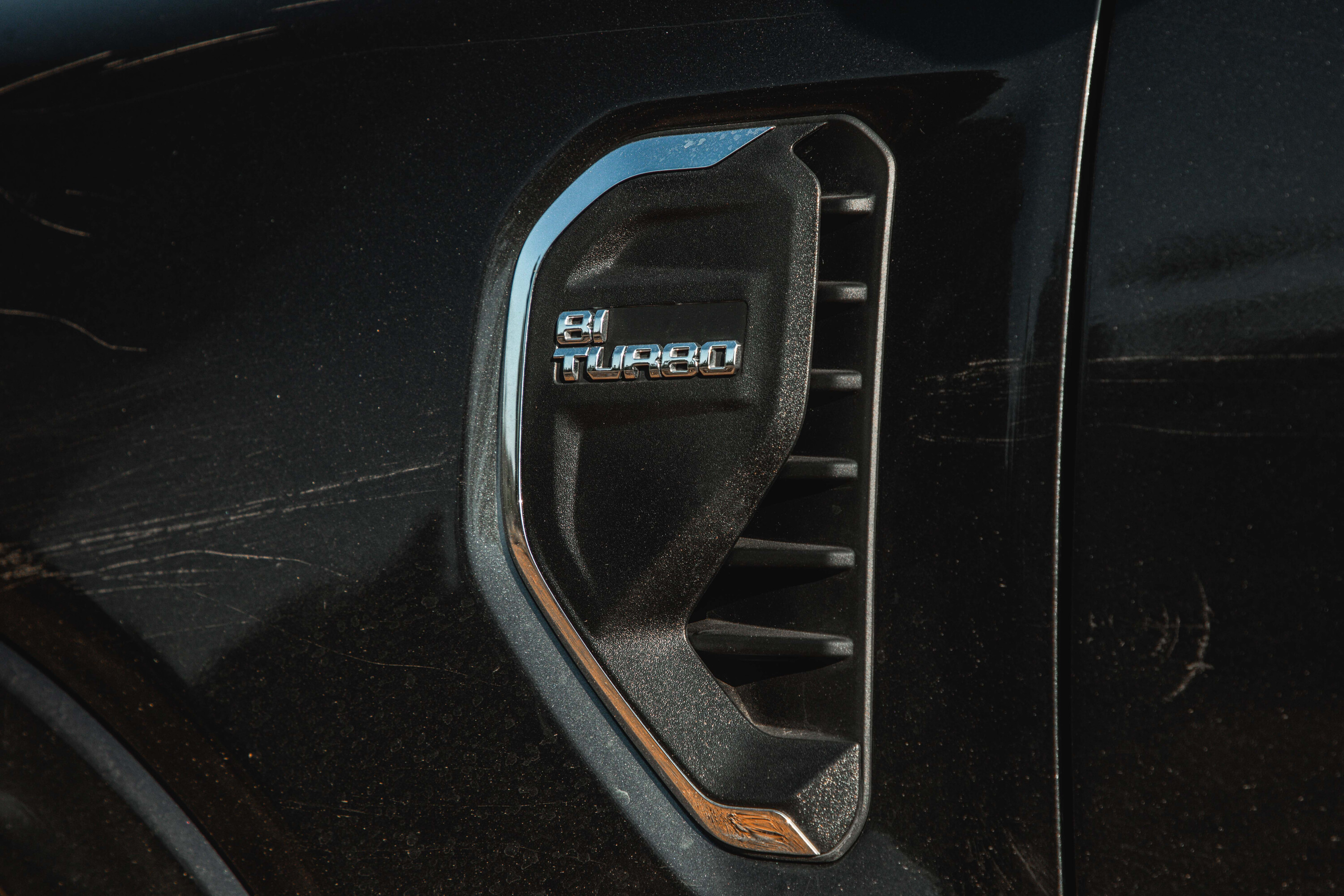
Active cruise control with stop and go, auto high beam, traffic sign recognition, roll-over mitigation, post-impact braking, trailer sway control and drive attention assist are also all standard.
There’s also a standard reversing camera and a seatbelt warning for every seat. Dusk-sensing headlights, nine airbags and the mandatory stability control top-up an very strong standard safety package.
The Everest Platinum’s Active Park Assist, 360-degree camera and tyre pressure monitoring add to what is already extensive safety across the range.
The Australasian New Car Assessment Program (ANCAP) rated all models of the current-generation Everest at five stars for safety, its maximum, in 2022.
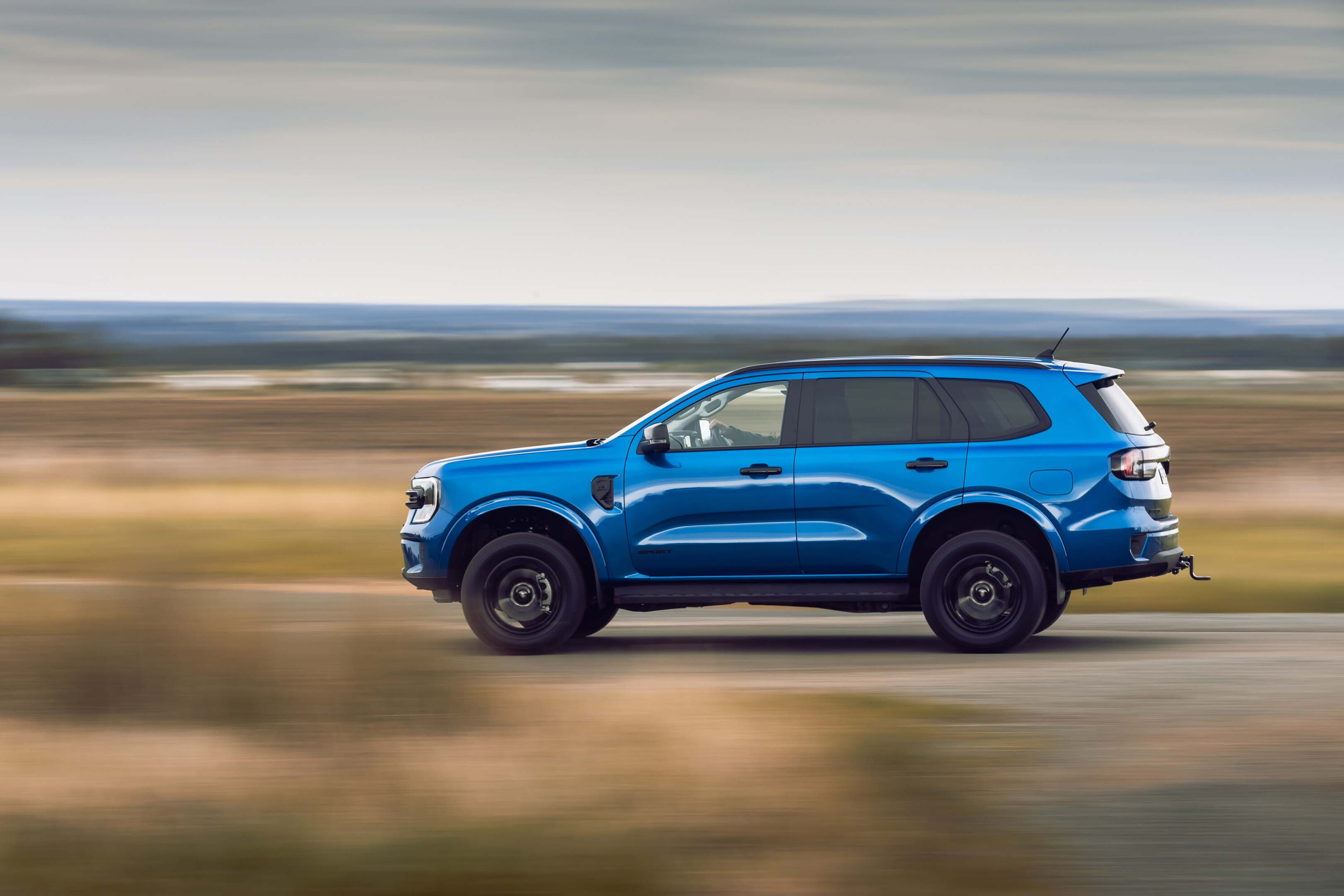
How comfortable and practical is the Ford Everest?
In a segment where driving position can be a compromise, cabin plastics are not always contemporary let alone made of anything like premium materials and infotainment systems are outdated, it’s refreshing to jump into an interior that nails the basics.
Up front, the seats are comfortable, the mix of materials strikes a nice balance between feeling premium and hardwearing, and there’s ample storage thanks to large cup holders, generous door bins and a deep centre console.
The cabin design feels modern and premium, too, and the Everest trounces its rivals when it comes to infotainment.
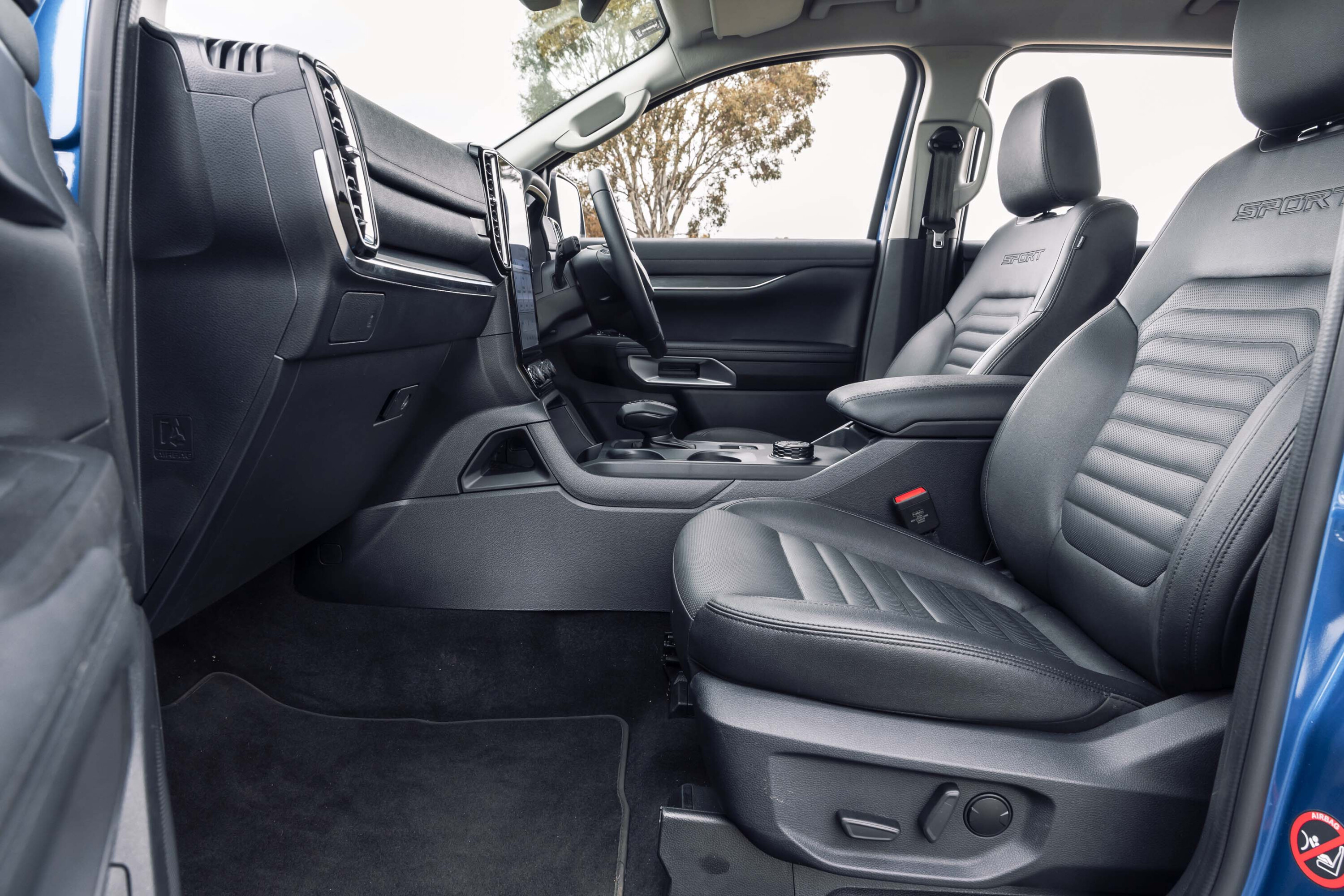
Like the new Ranger, the Everest is built on Ford’s heavily updated T6.3 platform
The portrait-style 12.0-inch central screen In Trend and Sport) is quick to respond and easy to navigate thanks to a logical menu structure and, mercifully, it retains a dedicated panel for the HVAC controls at the bottom so you don’t have to click through multiple submenus to adjust the temperature or fan speed.
There’s also plenty of room in all three rows. Like the new Ranger, the Everest is built on Ford’s heavily updated T6.3 platform and the wheelbase has been stretched by 50mm. Unlike the new Ranger, however, which has a slightly cramped rear seat, the Everest’s second row offers plenty of space.
Ford says the middle seat has been redesigned to improve passenger comfort and Trend variants and above also score an additional set of USB ports (to make a total of five), which is useful to keep the kids’ devices powered up.

As before, the second row slides but its movement fore and aft has been increased this time around to improve access to the third row.
Speaking of, those relegated to the very back seats won’t feel too hard done by thanks to improved shoulder room and decent vision out through large windows.
Taller adults might find it a touch squishy for knee- and headroom but there’s plenty in the way of amenity including two cup holders, a slot to store a tablet and dedicated air vents in the roof.
And importantly, curtain airbags cover all three rows of seats regardless of what Everest variant you choose. In fact, the level of standard safety equipment is impressively high across the entire Everest range.
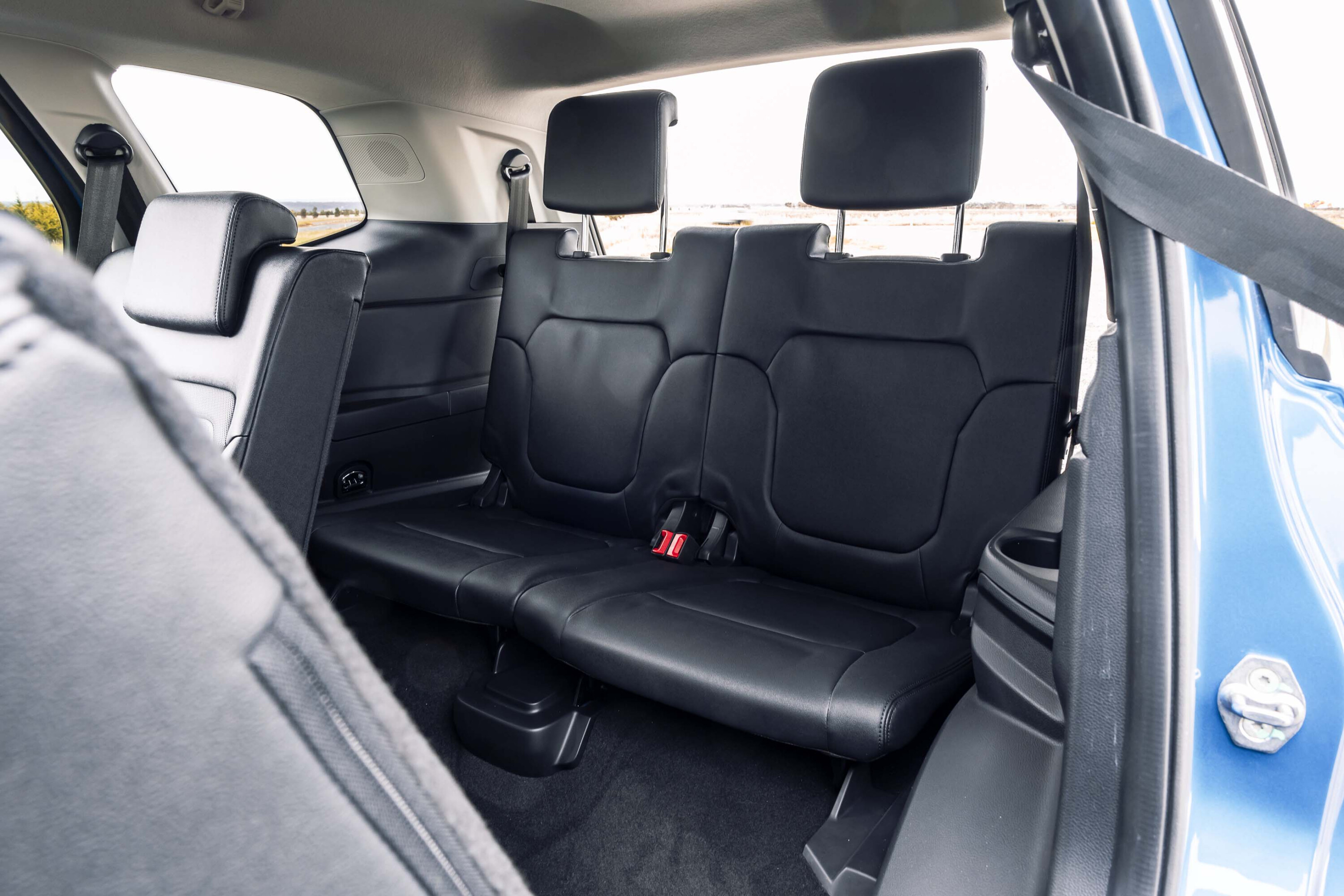
How much boot space does Ford Everest have?
Boosting the wheelbase and fitting a boxier, more muscular body has also improved the Everest’s luggage space.
With all three rows of seats in use, Ford says there’s 259L of boot space available which is large enough for a few golf bags stacked on top of one another.
Drop the third row and your boot grows to a generous 898L or with all the back seats folded you’ll have 1823L at your disposal. Need some context? A Fortuner offers 200L/716L/1080L so it’s a clear advantage to the Ford in the load-lugging stakes.

I like driving – will I enjoy this car?
Yes. The Everest is no hill-climb special but is among the much more satisfying large SUVs to drive from the traffic crawl to Outback touring.
This is the Everest’s biggest strength. In a segment that tends to feel fairly agricultural when it comes to steering feel and bump compliance, the Everest’s dynamics are remarkably polished. Even tight and challenging mountain roads, that would have made most large SUVs feel slow and ponderous, the Ford took on more like a traditional monocoque family SUV than a ladder-framed wagon.
The steering is naturally weighted and a good speed at 3.2 turns lock to lock, plus there’s none of the vagueness off centre that you get with many rivals. The seating position is bang on, too, thanks to ample reach and tilt adjustment on the steering wheel.
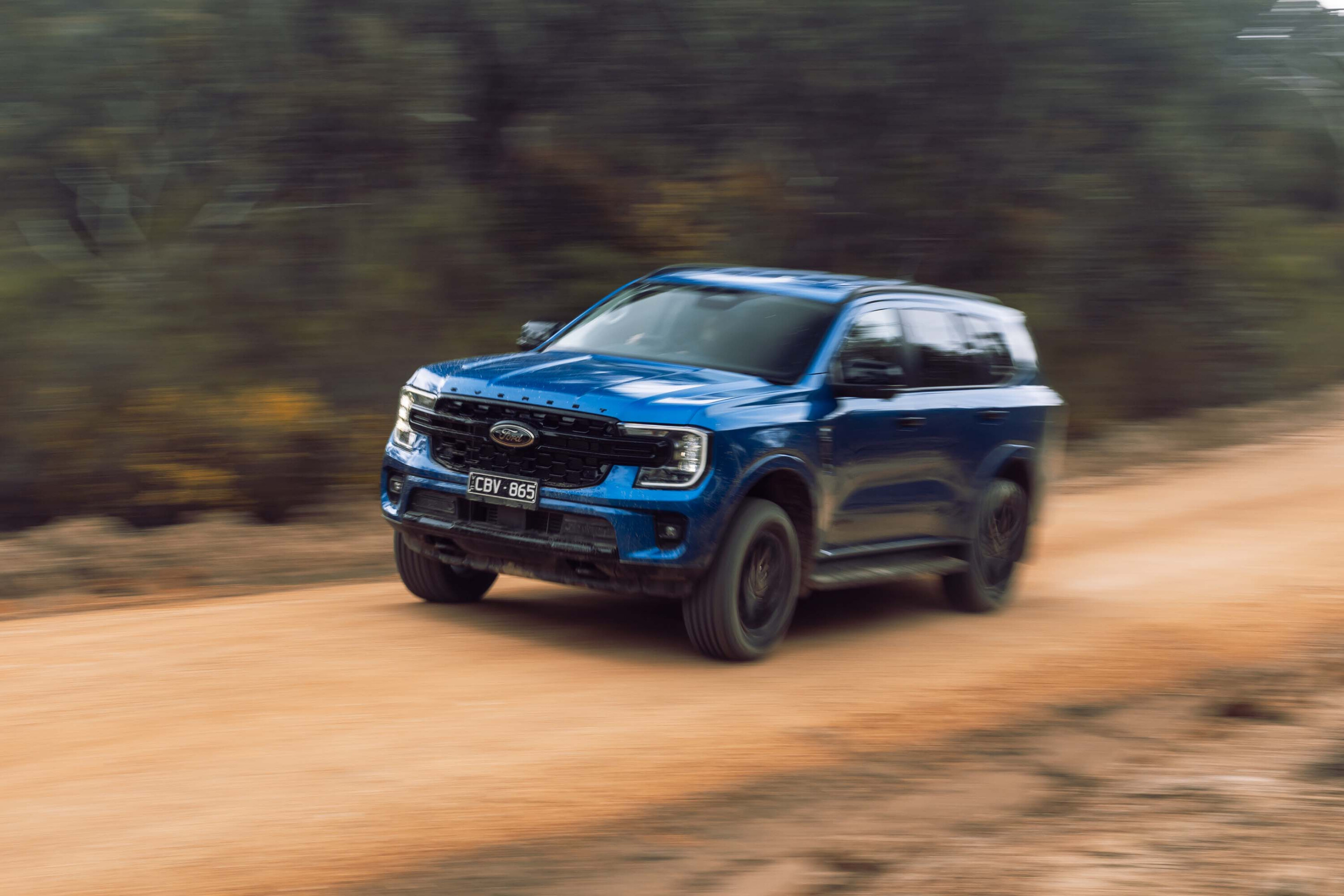
Excellent visibility is aided by enormous wing mirrors and cabin refinement is class-leading. Ford went to great lengths to reduce wind noise and improve cabin insulation, and the result is a large off-roader that’s impressively quiet on the freeway.
Body control is also nicely contained for such a big vehicle. On twisty sections, the Trend stayed commendably flat and unflustered despite several quick changes of direction. Happily, the ride is also relatively supple, despite the firm hand needed to keep the body in check, and the Trend’s 18-inch alloys do a decent job of ironing out all but the biggest of surface imperfections.
You do occasionally notice a telltale tremor or shake through the body that plagues all body-on-frame vehicles but for the most part, the Everest handles like a conventional SUV.
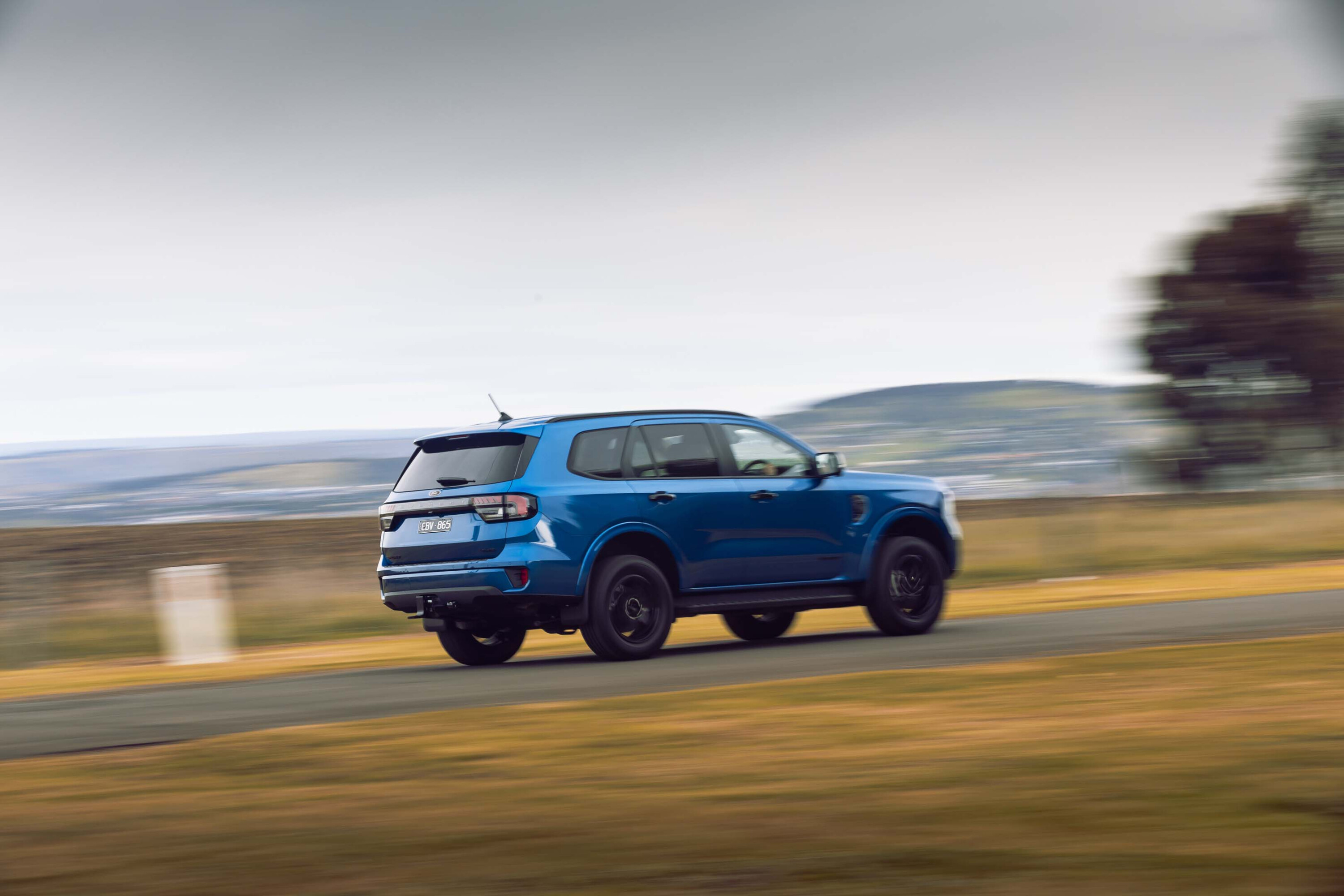
One thing that does erode the cabin’s sense of refinement, however, is engine noise.
The 2.0-litre bi-turbo is impressively quiet on the freeway but it can get vocal at higher revs and under hard acceleration there’s noticeable diesel clatter to contend with.
At least there’s plenty of performance to exploit. With 154kW/500Nm on tap, the diesel feels reassuringly muscular and while the engine is mostly carried over from the previous Everest, Ford’s engineers have made changes to improve reliability.
The 10-speed automatic transmission has also been improved. In the previous Everest and Ranger, it could hunt for the right ratio but this time around it’s more assertive. In saying that, the gearbox isn’t perfect. We felt the occasional bum shift and on a part throttle over hilly terrain, there was some driveline shunt.

Still, there’s no denying the 2.0-litre/10-speed combo is one of the strongest powertrains in this segment. It’s just a shame that there’s an even better engine within the Everest range…
The 3.0-litre V6 is smoother, quieter and with 184kW/600Nm it’s also noticeably more muscular. Weirdly, the performance gap between the 2.0-litre and 3.0-litre engines feels wider than it does in the Ranger.
In the Everest, the V6 is noticeably more urgent and while every Everest has a braked towing capacity of 3500kg, it’s the larger capacity engine we’d recommend if you plan to tow on a regular basis.
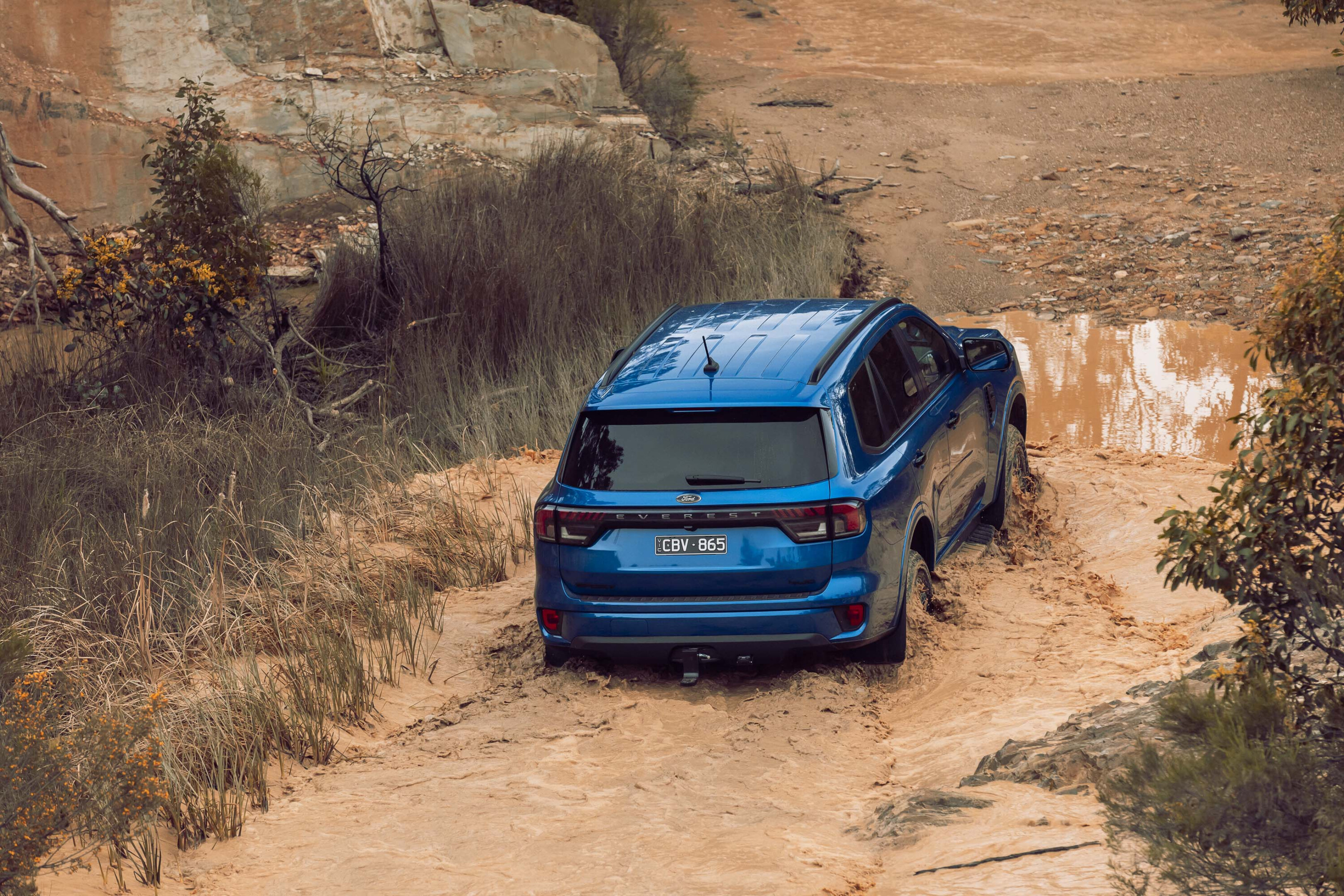
Away from paved roads, the Everest continues to be one of the most capable 4×4 wagons you can buy.
Ford’s engineering team set a goal early in development that the second-gen Everest had to be better to drive on-road and off-road, not one or the other, and in several key metrics this new model is an improvement.
Moving the wheels closer to the corners of the body has increased wheel articulation and reduced head toss for occupants. Shorter overhangs have also improved the approach and departure angles, which now sit at 30.4 degrees and 25.3 degrees respectively. The ramp-over angle is also better than before at 22.2 degrees.
If any of the terms in this section have left you scratching your head, these articles will help bring you up to speed!
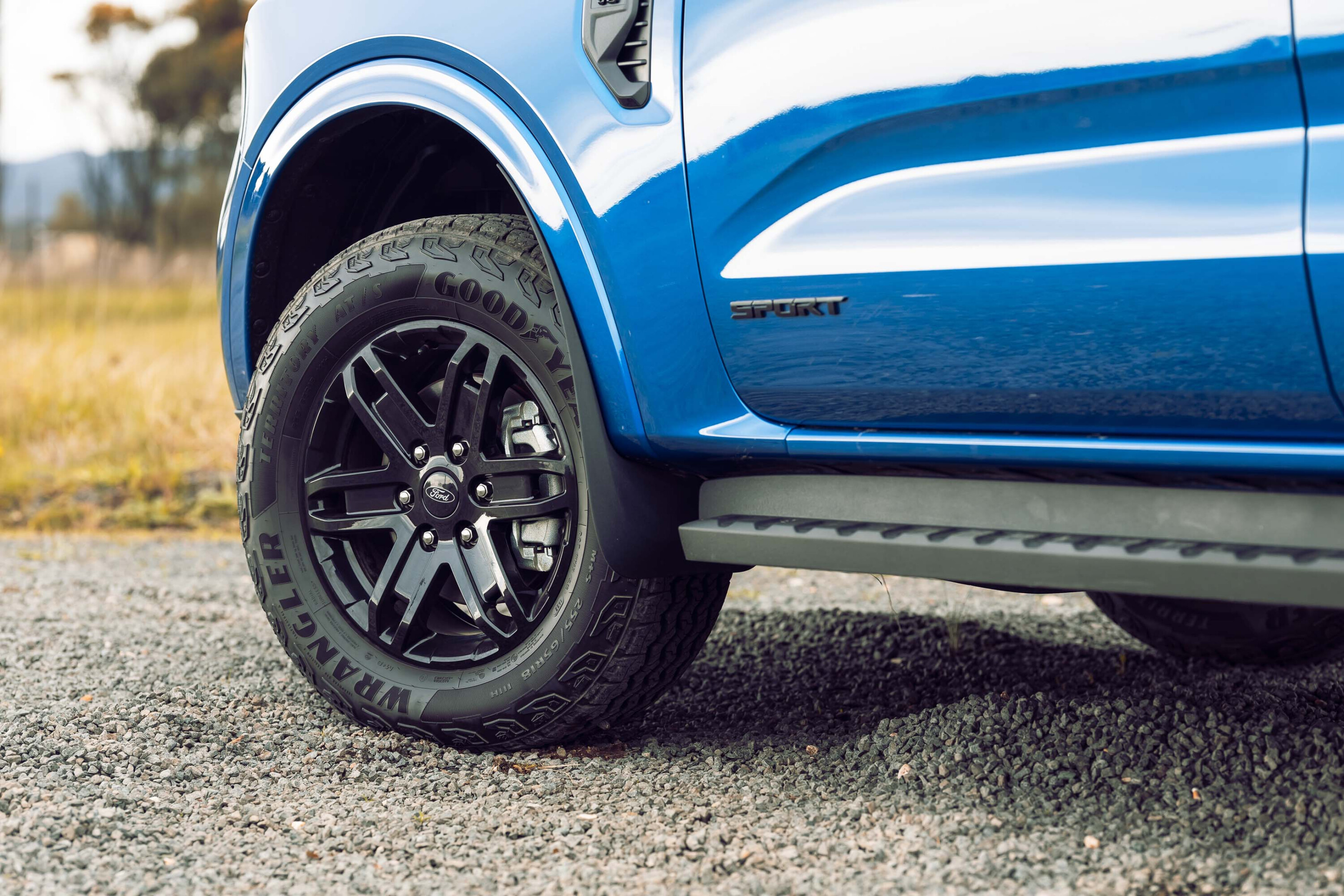
- What is a Powertrain or Drivetrain?
- Power vs torque
- Car suspension explained
- Automatic transmissions (‘gearboxes’) explained
- Chassis control systems explained
- Car vs Ute vs SUV: How the vehicle you buy should guide the way you drive
- What is the WLTP emissions and range test?
The 80-litre fuel capacity suggests a decent range on one tank of fuel, with a combined-cycle average of 7.2L/100km for 2.0L 4WD models or 8.5L/100km for the 4WD-only 3.0L V6.
Even if you manage to repeat exactly the V6’s average claimed consumption you’d still get 941km before running out of a full tank.
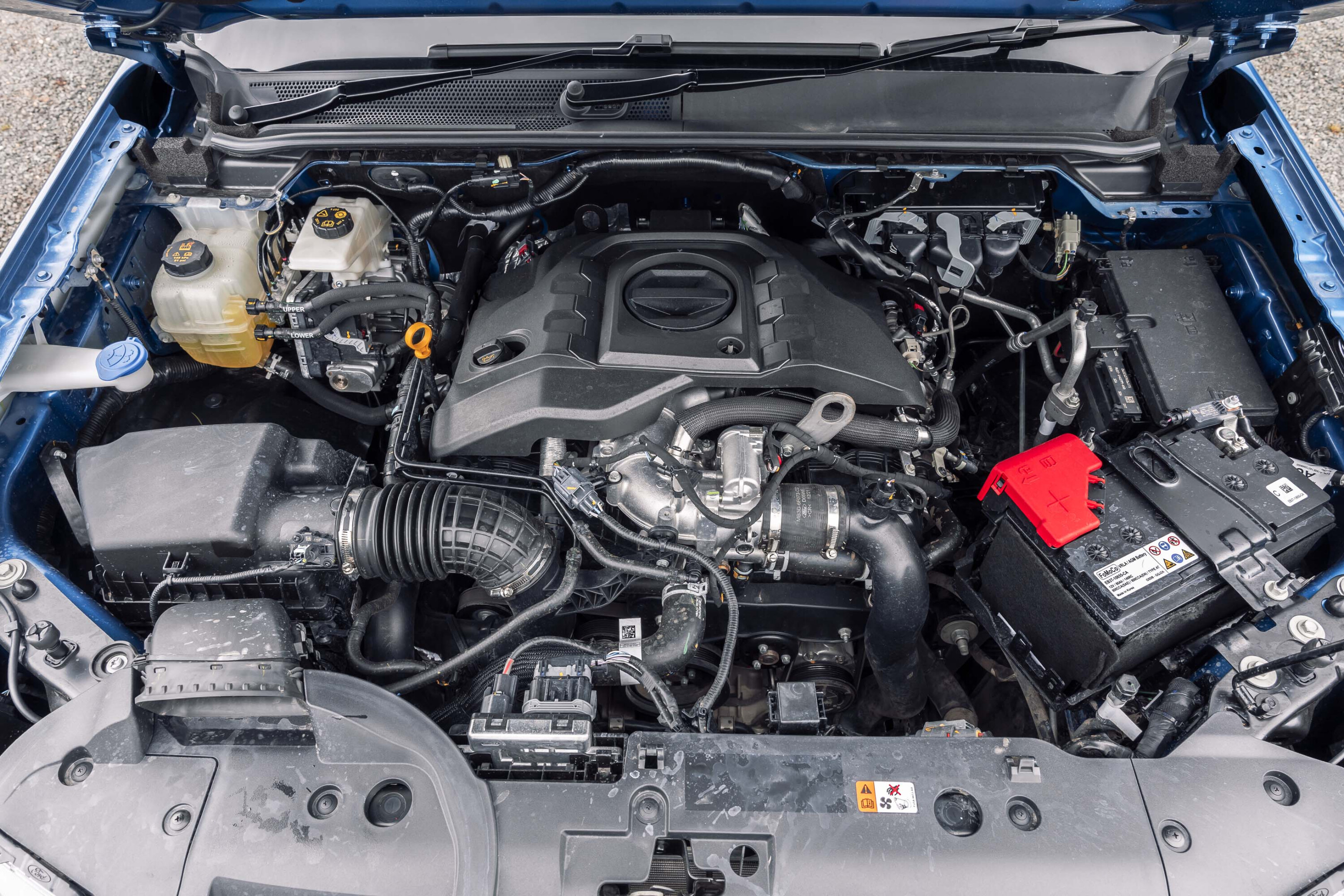
What is the Ford Everest’s towing capacity?
The Ford Everest has a braked towing capacity of 3500kg, with a towball rating of 350kg.
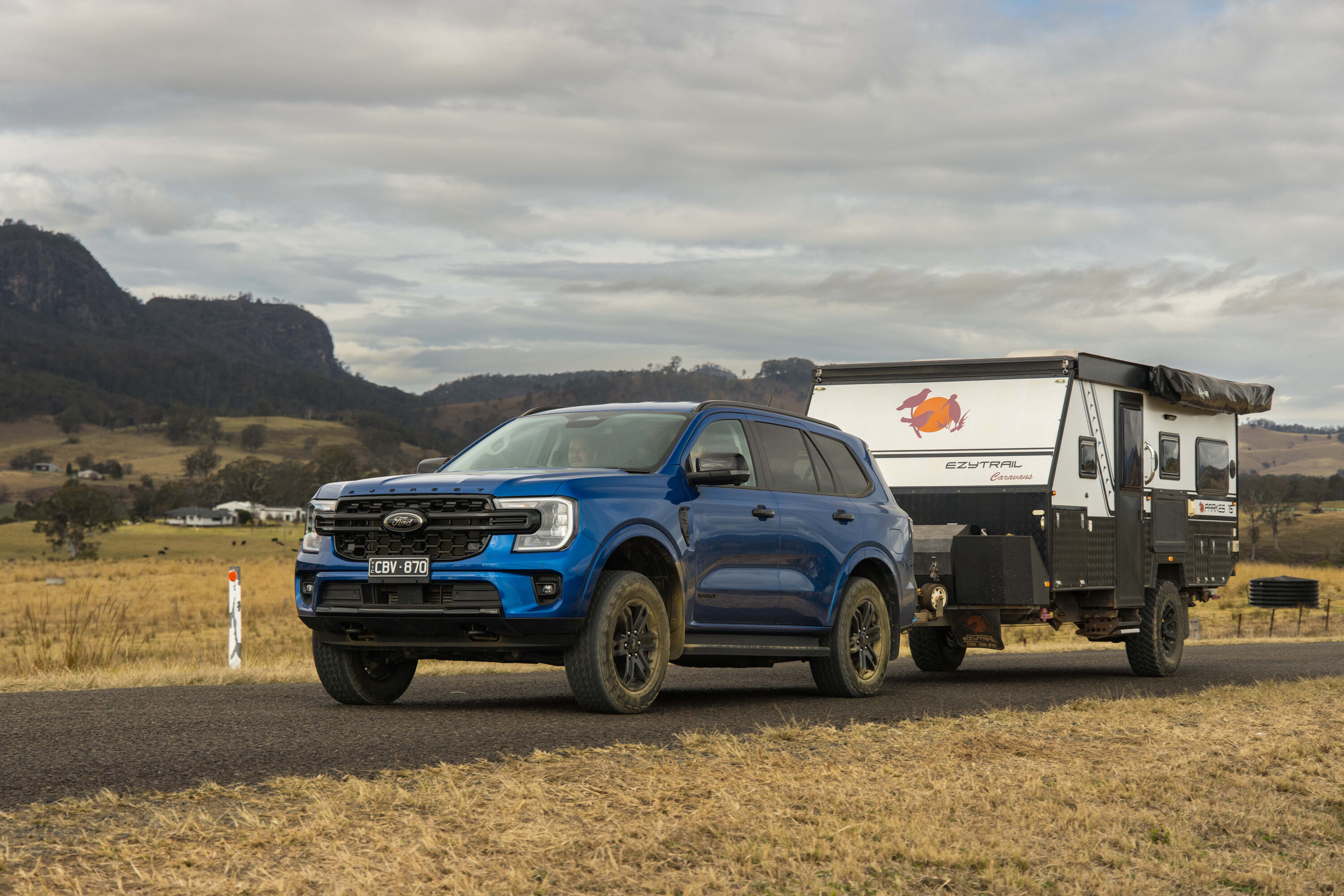
How long is the warranty and what are the Ford Everest’s servicing costs?
The Ford Everest comes with a five-year, unlimited-kilometre warranty with 12 months of roadside assistance also included.
You’ll need to visit the dealer for scheduled servicing every 12 months or 15,000km, whichever occurs first, and the most you’ll pay for each of the first four visits is $329 under Ford’s capped-price servicing program.
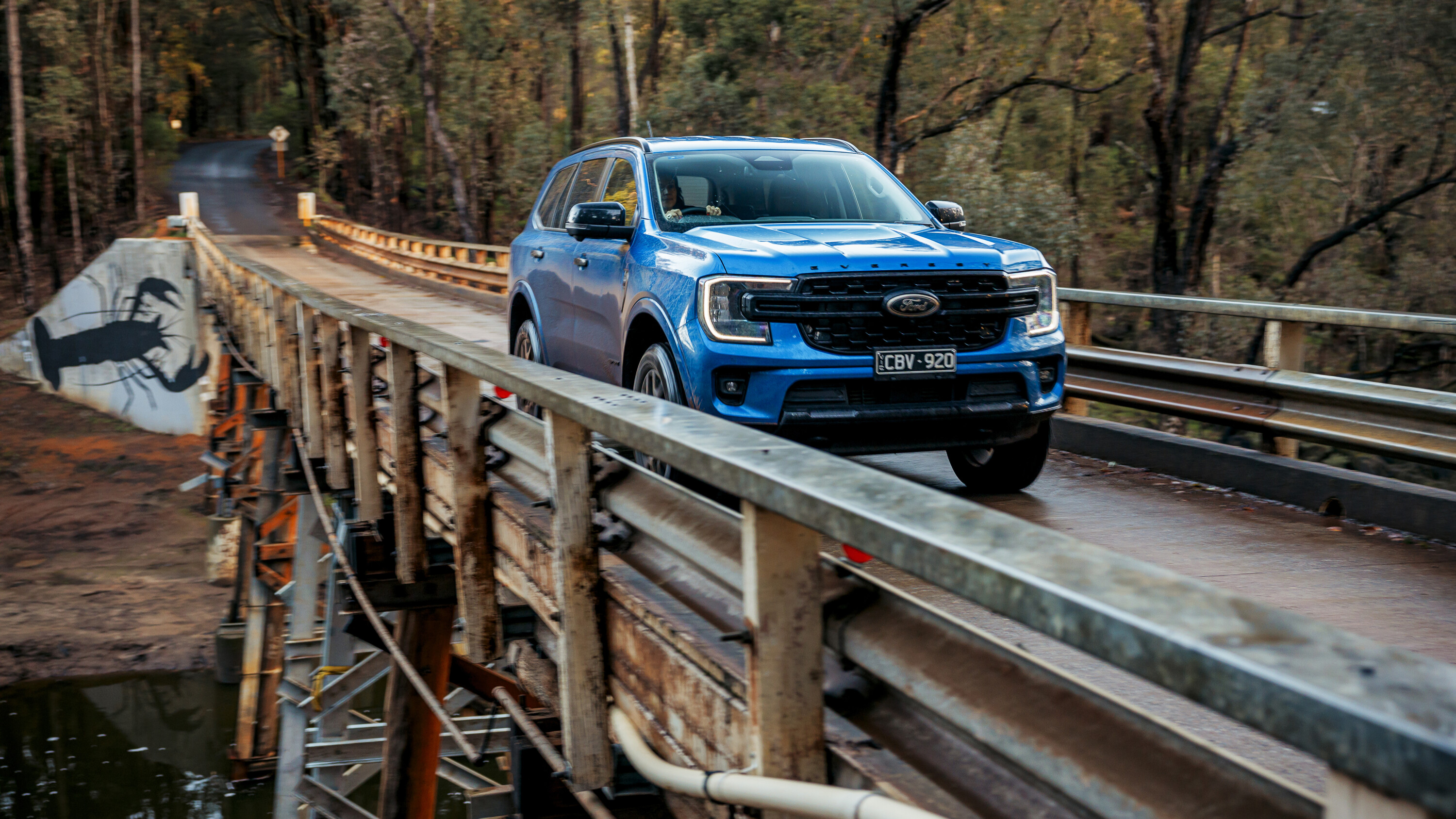
Which version of the Ford Everest does 4X4 Australia recommend?
There is so much tech and particularly safety equipment thrown into the base model, but for that extra bit of bling – and sensible extra gear – the Everest Trend 4WD is worth the extra money.
The problem is that for not quite $5K more, you can get the Sport 4WD with its V6 engine – which opens up a while lot more performance, potentialespecially if you’re towing heavy trailers.
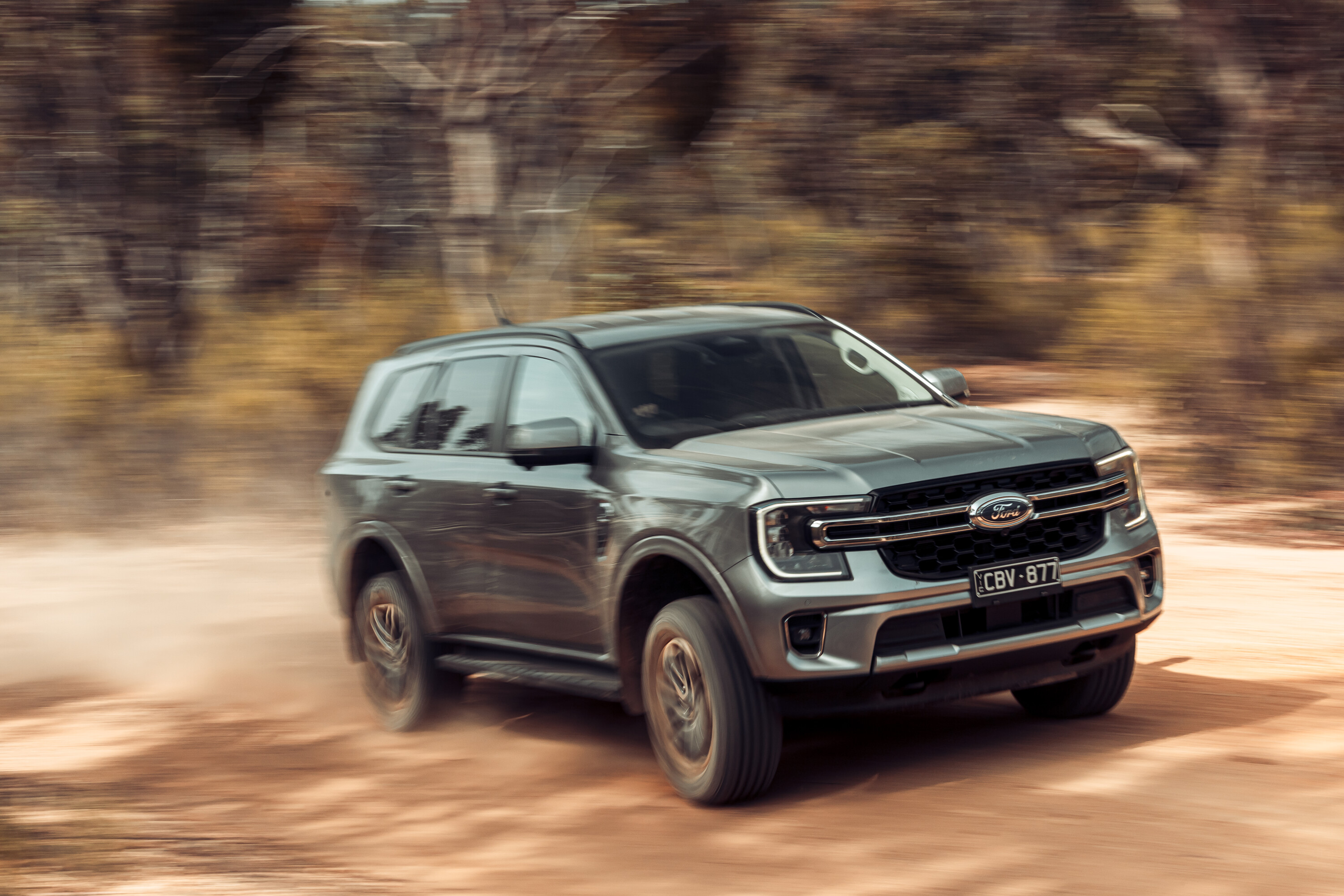
What are the Ford Everest’s key rivals?
Score breakdown
Things we like
- Great powertrain combinations
- Benchmark ride and handling for a ute-based SUV
- Extensive tech features
- Spacious and practical cabin
Not so much
- Ride not perfect when roads get rough
- Manual mode not ergonomic
- Occasional transmission shunt

